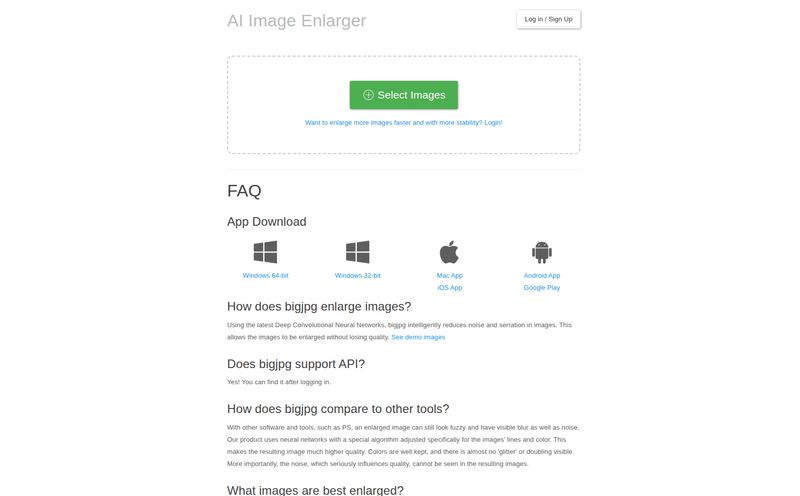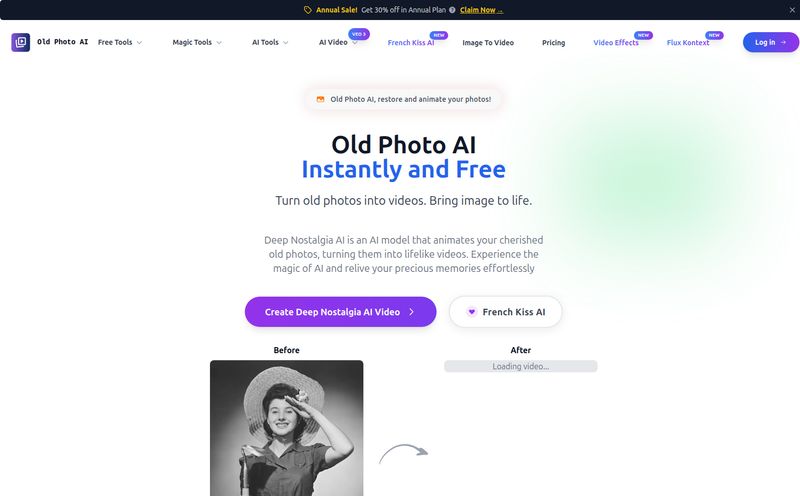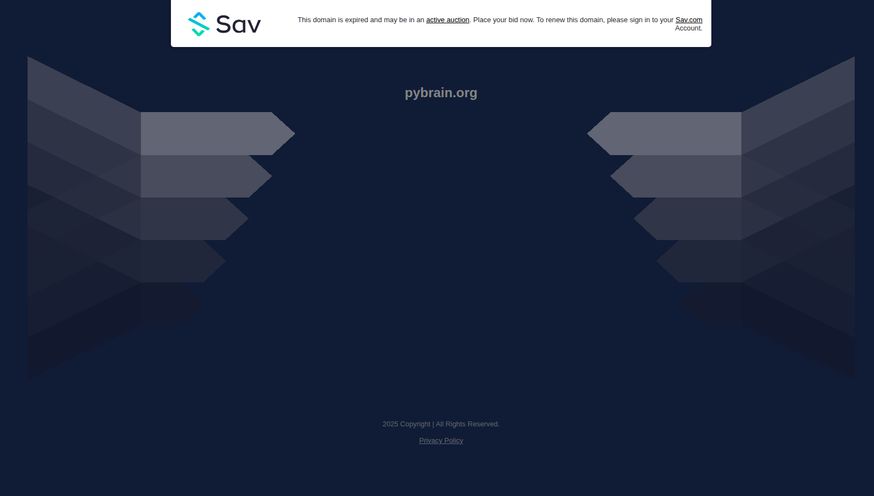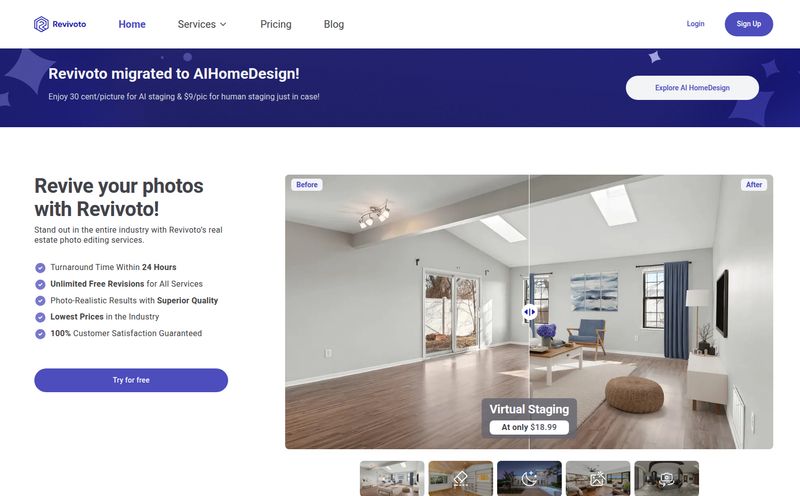If you're in the content game—whether you're an SEO, a blogger, a marketer, or a small business owner trying to do it all—you know the pain. The existential pain of the perfect, almost-but-not-quite-high-res-enough image. You've found it. The one. It captures the exact mood for your article. But it's 400 pixels wide and looks like it was captured on a potato. We've all been there.
For years, I've been on a quest. A quest for an AI image upscaler that doesn't just make pixels bigger, but actually makes them better. One that doesn't turn faces into waxy, uncanny valley nightmares. I've tried dozens of tools, some free, some wildly expensive. So when I stumbled upon Gigapixel AI, which claims to be an 'all-in-one professional AI platform,' my inner cynic raised an eyebrow. Another one? But my optimistic side, the one that still believes in digital magic, decided to give it a spin. And I have to say, its a pretty interesting tool.
So, What is Gigapixel AI, Anyway?
First off, Gigapixel AI isn't just one thing. I think that’s their main play. While the name screams 'upscaler!', it's actually more of a creative suite. Think of it less as a single screwdriver and more like a Swiss Army knife for your images. The homepage immediately throws a bunch of tools at you: an AI Image Upscaler (the main event), an AI Video Upscaler, an Image Generator, an Editor, a Background Remover... the list goes on. It's ambitious.
The core promise, especially for the upscaler, is that it uses some fancy AI to intelligently enhance images up to 10x their original resolution. It claims it does this while keeping details sharp, textures natural, and colors vivid. A tall order, because anyone who has ever tried to just 'Enlarge Image' in Photoshop knows the blurry, artifact-ridden mess that usually results.
The Main Attraction: The Gigapixel AI Image Upscaler
This is what I came for. The heart of the platform. I've got a whole folder of 'maybe-one-day' images that are just too low-quality to use professionally. So, I decided to throw a few of them into the fire.
How Does the Magic Happen?
The platform says it doesn't just stretch the image. It reconstructs it. The AI was trained on millions of images to understand what things should look like. It identifies edges and sharpens them, reduces that grainy 'noise' you get in low light photos, and enhances fine details like fabric textures or strands of hair. It's less like a photocopier and more like a digital art restorer, painstakingly filling in the gaps with educated guesses. And frankly, its guesses are scarily good.
Putting It to the Test
I started with a picture of a landscape I took on an old phone years ago. It was sentimental, but completely unusable for a blog post. I uploaded it, selected the 4x upscale option, and held my breath. The processing took about a minute, which felt a little long in our instant-gratification world, but hey, I can wait for quality.
The result? Genuinely impressive. The blurry mountains in the background became crisp. The leaves on the trees, which were once a green smudge, now had definition. It wasn't just bigger; it was clearer. It was the photo I wished I had taken.
Visit Gigapixel AI
Next, a portrait. This is where most AI tools fall apart. I used a photo of a friend (with permission, of course!) that was a bit soft and out of focus. Gigapixel AI did an amazing job on the hair and the fabric of her shirt. The face was... better. It avoided the waxy, over-smoothed look, but it wasn't quite perfect. Still, it took an unusable photo and made it usable. A definite win.
Beyond Upscaling: A Quick Look at the Full Toolkit
While I was mainly there for the upscaling, I couldn't resist poking around the other tools. Here’s a quick rundown:
- AI Image Generator: It's what you'd expect from the current AI art boom. You type in a prompt, it spits out an image. It's a nice addition, especially if you need a truly custom hero image for an article.
- AI Video Upscaler: The same principle as the image upscaler but for video. This could be huge for anyone working with older footage.
- Background Remover: A one-click tool to isolate a subject. Incredibly useful for creating product photos or professional headshots. It worked cleanly on the images I tried. A huge time saver.
- Image Style Transfer: This lets you apply the style of one image (like a Van Gogh painting) to another. It's more of a fun, creative toy but could have some cool applications for unique branding.
The Good, The Bad, and The Pixelated
No tool is perfect, right? After spending a good few hours with the platform, here are my honest takeaways.
What I Absolutely Loved
The quality of the upscaling is, without a doubt, the star of the show. It consistently delivered results that were miles ahead of basic resizing methods. But the real surprise hero for me was the batch processing. The ability to upload a whole folder of images and have them all upscaled in one go is a massive workflow improvement. As someone who often has to prep 10-20 images for a single pillar page, this feature alone is almost worth the price of admission. It's also remarkably easy to use. The interface is clean, and you don't need a degree in graphic design to figure it out.
A Few Minor Gripes
Okay, it's not all sunshine and high-res rainbows. The processing time can be a bit of a drag. If you're in a massive hurry, waiting a minute or two per image might feel like an eternity. It's a trade-off for quality, but one to be aware of. Also, the credit system. I have a love-hate relationship with credit systems. On one hand, you only pay for what you use. On the other, it can feel a bit like an arcade, watching your tokens disappear. The provided info I found initially said there were no free credits, which would have been a deal-breaker, but thankfully their site shows a Free plan with a few daily credits. Phew.
Let's Talk Money: Breaking Down Gigapixel AI's Pricing
This is always the big question. Gigapixel AI runs on a credit-based subscription model, which is pretty common for AI tools these days. Here’s how it breaks down:
| Plan | Price | Credits | Best For |
|---|---|---|---|
| Free | $0 / Day | 8 Credits / Day | Casual users, testing the platform. |
| Starter | $8.90 / Month | 100 Credits / Month | Freelancers, bloggers, small projects. |
| Premium | $23.90 / Month | 1500 Credits / Month | Power users, small agencies, content creators. |
| Unlimited | $49.90 / Month | Unlimited Credits | Large agencies, businesses with high volume needs. |
Note: Pricing is based on information from their website at the time of writing and might change. Always check their official page for the latest details.
In my opinion, the Premium plan seems to offer the best bang for your buck if you're a serious content creator. 1500 credits is a lot of runway for a month's worth of content. The Starter plan is great if you only need to fix an image occasionally.
So, Who is Gigapixel AI Really For?
After all this, who should actually sign up? I see a few key groups:
- Content Marketers and SEOs: We're always hunting for high-quality images. This tool can rescue so many 'almost perfect' shots from the scrap heap and even create new ones. The batch processing is a godsend.
- Photographers: A great tool for rescuing older digital photos, or even up-sampling cropped images to make them printable.
- Web and Graphic Designers: When a client gives you a postage-stamp-sized logo and asks you to put it on a billboard, this is your new best friend.
- Hobbyists and Enthusiasts: The free plan is more than enough to play around with, restore old family photos, and just have some fun.
My Final Verdict: Is Gigapixel AI a Keeper?
So, has my quest ended? For now, yes. Gigapixel AI has earned a firm spot in my bookmarks bar. It's not just an upscaler; it’s a robust image creation toolkit that solves a very real, very frequent problem for people like me.
While it's not instantaneous and the credit system requires some thought, the sheer quality of the output and the time-saving features like batch processing make it a powerful ally. It successfully turns digital water into... well, maybe not wine, but at least high-quality, very drinkable grape juice. And in the world of content, that's often exactly what you need.
Frequently Asked Questions (FAQ)
- What is Gigapixel AI primarily used for?
- Gigapixel AI is primarily an AI-powered image enhancement platform. Its most popular feature is the AI Image Upscaler, which increases image resolution up to 10x while intelligently improving sharpness, reducing noise, and restoring details.
- Is Gigapixel AI free to use?
- Yes, there is a free plan. It offers a limited number of free credits (currently 8) that reset every 24 hours. This is great for trying out the service or for very light, occasional use. For more frequent or professional use, you'll need one of their paid subscription plans.
- How does the AI upscaling actually work?
- It uses a deep learning neural network that has been trained on millions of images. Instead of just making pixels larger (which causes blurriness), the AI analyzes the image and 'reconstructs' it at a higher resolution, adding detail and clarity based on its training. It's essentially making highly educated guesses about what the missing details should be.
- Can I use the images I enhance or create for commercial purposes?
- According to their pricing page, a Commercial License is included with all the paid plans (Starter, Premium, and Unlimited). It's best to review their terms of service for specific details, but yes, paid plans are intended for professional and commercial work.
- What kind of images work best with Gigapixel AI?
- It's optimized for a wide range of images, including portrait photography, natural landscapes, architectural shots, and even digital illustrations. I've found it works best on images that are a bit soft or low-resolution to begin with, rather than images that are already extremely blurry or have huge chunks of missing data.



